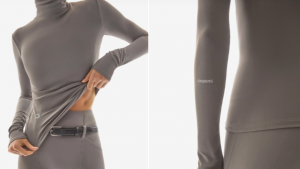
University of Brighton graduate India Harris’ textile collection, Method To The Madness, is inspired by film photography. “I was initially inspired by hand-tinted photographs from the 19th century,” she says.
“Photographic imagery is also an integral part of my aesthetic. Being able to combine textiles and photography is such an enjoyable way of producing work and it always inspires me,” Harris says.
She cites Tim Walker – who regularly shoots for Vogue, W Magazine and LOVE Magazine – as a particularly strong influence in her work. The British fashion photographer’s influence is clear in Harris’ graduation project; it smacks of the same whimsical and playful elements that Walker is known for.
The inspiration behind her Method To The Madness textile designs is captured in her graphic mood boards showing influences from photography, scrapbooking, collaging and the Columbia Road flower market in London, which she loves because “of the people it attracts and the wide variety of flowers and exotic plants for sale”.
“Working with textiles in the industry I have learnt how important they are,” she says. “Textiles are a part of everyone’s lives and the starting point of all fashion concepts and development.”
It’s an insight shared by fashion forecaster Li Edelkoort, who sees a loss of competence in textile manufacturing as one of the underlying factors contributing to the breakdown of the fashion industry, as we know it.
Harris is trained in handpainted and silkscreen techniques, which she calls a “dying art”. “Silkscreen printing creates beautiful fabrics that have movement and body, but the process is expensive and a lot of universities and colleges won’t teach it to their students anymore either because of [a lack of] resources or because it is just not needed with digital printing,” she says.
As the industry moves towards digital, she knows that her skills are rare: “I think that textiles will be predominantly digital, and most companies will have their cloth digitally printed.”
This means that we’ll lose both the beautiful printed fabrics that silkscreening yields and the craft behind designing these textiles. The mass-market retailers aren’t helping. “With high-street shops that promote fast, throw-away fashion, textiles will never be fully appreciated for the hard work that goes into them,” she says.
“People think that you are restricted with textiles as it is such a specialist field but I have found that studying textiles has always opened doors.” She spent her “year out in industry” at DKNY in New York, where she worked alongside fashion designers developing prints, colour palettes and concepts.
Printed textiles for Harris meant the freedom to be experimental: “I liked seeing how you could translate a drawing or painting directly onto cloth and that you could create photographic prints with digital printing.”
Despite the ebb of textile skills, she remains hopeful. “I think more people are becoming conscious of sustainability issues,” Harris says. “People do want clothes that will last longer and made with fabrics that aren’t as damaging to the environment.”











